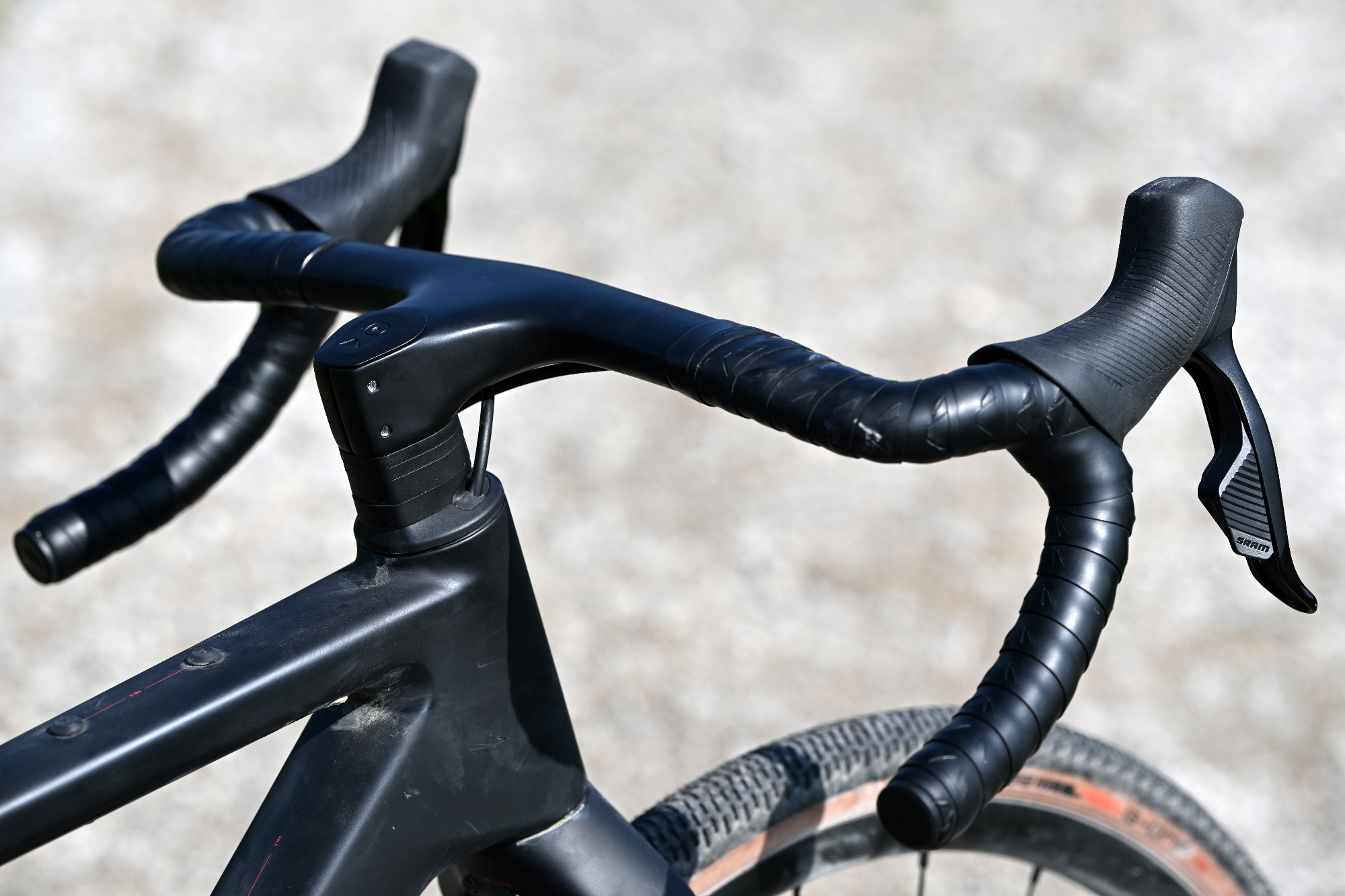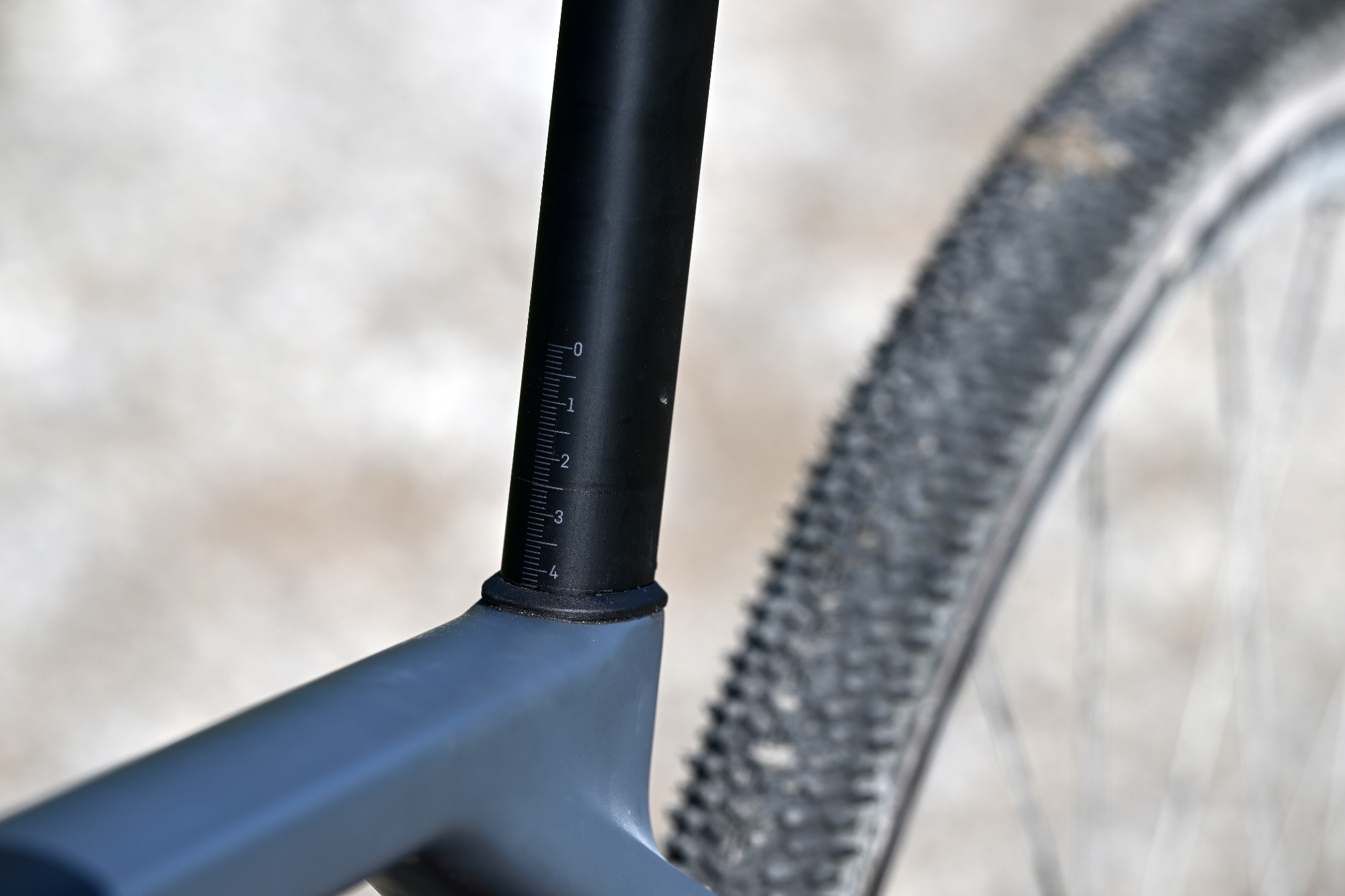
The Canyon Grail isn’t a stranger to us at Cycling Weekly. We included the previous generation in last year’s Gravel Bike of the Year testing and have already reviewed a high-end version of the current model when it was launched last October.
The entry-level Grail CF SL 7 AXS is a classy-looking bike with many features you wouldn’t expect at this price point including aero-tubing and an integrated cockpit. But how would this budget race-ready machine perform on the trails and against the other contenders in this year's Gravel Bike of the Year awards.?
The construction
There are three levels of carbon frame within the Grail range, all of which have the same geometry, tubing and mounts. The SL version on test is the lower end of these, and so is heavier and less stiff than the higher-end frames. It also forgoes any internal storage.
The construction and styling of the Grail gives it clean and modern look with straight lines running across the bike. I particularly like the shaping of the tubes as the seat stays run into the seat and top tube junction.

Our extra-small model (recommended for riders 167 – 175cm) had a 1024mm wheelbase, 425mm chain stays, 71o seat tube angle and 73.5o head tube angle putting it, geometry-wise, mid-way between pure racing-biased and the more adventure-tilted bikes we had in our test, such as the Cotic Casacde.
Whilst most of the Grail’s geometry fell where expected, its relatively high stack (556mm) gives the Grail a higher front end than many other gravel race bikes.

Similar to the frame itself, the build of the entry-level Grail benefits from the trickle-down design of its fancier stablemates. This means the SL 7 boasts many aero attributes that are less common on similarly priced bikes such as an integrated cockpit, fully internal hoses and D-shaped seat post. The cockpit itself combines a 60mm stem and 420mm width bars (these dimensions increase with increasing frame size).

The Grail CF SL 7 AXS comes equipped with Schwalbe G-One 40mm tubeless ready (but not set up) tyres on DT Swiss Gravel LM wheels with 12mm bolt-thru axles. Maximum tyre is 42mm which is decent but on the narrower side compared to many of the bikes we tested for Gravel Bike of the Year, including the race-orientated Specialized Crux.
The drivetrain and brakes are all SRAM Rival AXS with 1x12 speed XPLR gearing (10-44T cassette) with a press-fit bottom bracket. The sizing of the crank arm length follows the modern trend of 'going small' with 165mm spec’d on our size XS test bike. This won’t be for everyone, but I think it’s good to see a greater range of crank lengths across the size-range rather than a one (or two) size fits all approach.
The ride
I was really excited about riding the Grail. Its look, geometry and spec suggested that it was just what I wanted for a summer of gravel riding; fast and purposeful but with the ability to venture onto more technical trails when I fancied scaring myself. I even had the opportunity to blast it down the same gravel tracks that featured in this year’s Tour de France.

The rear end of the bike was as quick and responsive as I hoped for; whether I was pedalling in or out of the saddle or willing it to whip through corners, it dutifully followed. It would get up to speed and stay there; I could make my legs burn if I wanted but sit and cruise when needed
When really cranking out the saddle it’s possible to have some fork flex and brake rub but, given the specification and price point, it’s not concerning. The press-fit BB did its fair share of creaking too, but again (for right or wrong) nothing out of the ordinary. So, at this point, all good.

However, the front end of the bike felt completely mismatched to both me and its own rear end. Firstly it was quite short, so didn’t put you in a long, low, racy position. This shortness isn’t through the frame itself (the reach is pretty standard for a racing-leaning gravel bike) but the stem which was around 20mm shorter than similarly designed bikes of the same size.
Combining the shorter ‘overall reach’ with the generous stack results in quite an upright leisurely position. The height of the front end made me want to get in the drops to weight the front wheel but the shortness of the bike made this quite a crumpled position and not one I wanted to stay in.

The other anomaly of the front end was the relatively wide bars - 420mm for an XS bike is generous (420mm on the three smallest sizes, 440mm for medium and large, 460mm for XL and XXL sized bikes). Without being able to get up and over the front end and weight the front wheel, this width felt too much.
A closer look at the geometry charts makes me suspect that the “high and short” feel is much more prominent on the smaller models than the larger ones with the ratio between the “as built” stack and reach decreasing with increasing frame size.
Despite this, the bike's handling on both rough gravel and technical terrain was still good, obediently going wherever I needed it to. It just didn’t feel fast or fun.
Value
If it was down to looks and attributes the Canyon Grail CF SL 7 AXS would be hard to beat; with £3,299 (reduced to £2,949 at time of press) buying you full aero tubing, integrated cockpit and wireless shifting.
But, be warned, the downside of such technology at this price point is the relative expense of making any alterations. My main gripe could be mitigated with a longer and narrower cockpit but at £300, around 10% of the cost of the bike, that’s an expensive thing to try out.
Specs
- Frame and fork: Canyon Grail CF SL- carbon
- Rear Derailleur: SRAM Rival XPLR eTap AXS
- Cassette: SRAM Rival XPLR XG-1251, 12-speed, 10-44T
- Crank: SRAM Rival 165 mm
- Bottom bracket: SRAM Pressfit DUB Wide
- Chain: SRAM Rival D1 12s
- Brakes: SRAM Rival eTap AXS, 160mm rotor Wheels
- Wheels: DT Swiss Gravel LN
- Tyres: Schwalbe G-One R, 40mm
- Cockpit: one piece, 60 x 420mm, 16° flare on at drops, 5° backsweep
- Saddle: Fizik Vento Argo X5
- Seat post: Carbon (CF)
- Sizes: 2XS – 2XL (seven sizes)
- Max tyre clearance: 42 mm
- Weight: 8.9 kg (XS as tested)







